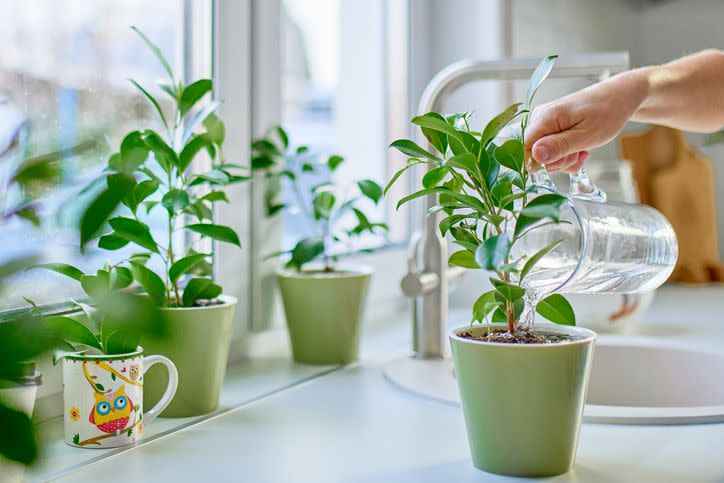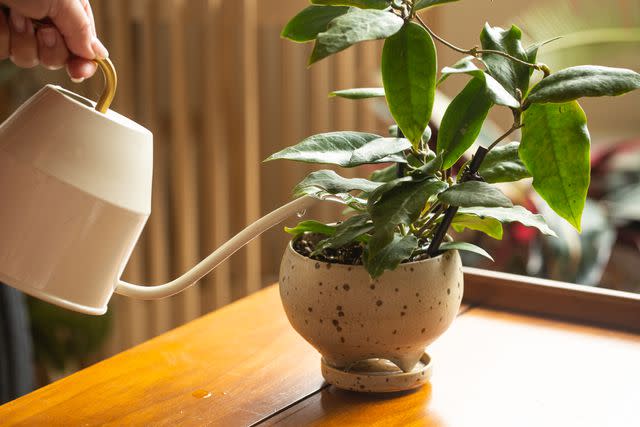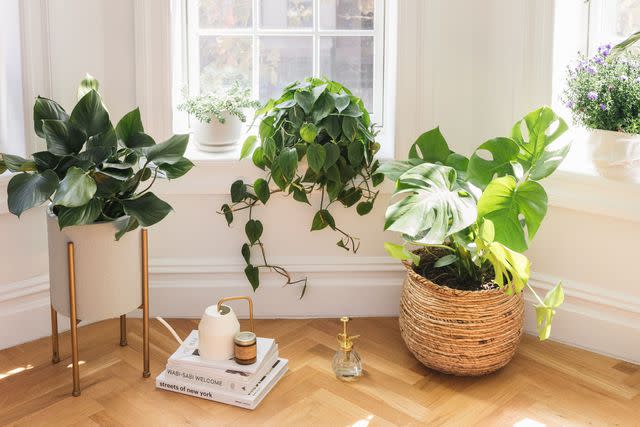5 Things Plants Need to Grow (and What They Do)

Elena Zaretskaya / Getty Images
Fact checked by Marcus Reeves
Keeping a houseplant collection in excellent shape means providing everything your plants need to grow and stay healthy. Some require more attention than others, but all indoor plants are dependent on you to provide the basic elements needed to thrive.
What Do Plants Need to Grow?
Light, air, water, nutrients, and adequate space are the five things a plant needs to grow. Nutrients can come from fertilizers, soil and, in some cases, air.
1. Light
All plants need some amount of light to survive. Light is the energy source used to convert carbon dioxide into food. Different plants grow best in various types of light and both amount and intensity are important. Light also affects temperature.
Give houseplants natural light by placing them in or close to a window or in a bright room. The amount of available sunlight fluctuates with the seasons, so you may need summer and winter locations for certain plants. Plants with low light requirements may survive under fluorescent lights.
For excellent growth, add a grow light. If you're unsure if your plant has enough light or not, try using a light meter to measure.
2. Air
Like all living things, plants need to breathe. They pull carbon dioxide from air and use carbon to break down sugars for food and energy to fuel new growth.
Providing fresh air for indoor plants can be a challenge, but there are ways exist to improve quality. Lightly dust or wipe leaves occasionally to improve respiration. Avoid placing sensitive plants in areas like kitchens where smoke and odors impact air quality. Keep areas around plants free of tobacco smoke and room sprays.
To improve air circulation, you can place a fan nearby.
3. Water

The Spruce / Phoebe Cheong
Water makes up to 95% of a plant’s tissues and is responsible for cooling and, transporting nutrients and sugars absorbed by roots to feed the rest of the plant, and structural support.
Some plants, like succulents, store water in their fleshy stems, leaves, and roots. Certain types of orchids and other epiphytic plants receive moisture from humid air through aerial roots. You can group plants together to increase transpiration and available moisture.
Almost all plants benefit from deep thorough watering but do not like to sit in water. Pots with good drainage holes and soil that drains well are important for good houseplant care. Set pots in a sink or container filled with water to absorb from the bottom (i.e., bottom watering). Self-watering pots, watering stakes, mulches and other specialty materials deliver water slowly and hold moisture.
4. Nutrients
Nutrients are plant food and combinations of vitamins, minerals and carbohydrates that fuel functions necessary for survival. Nutrients keep plants healthy and provide energy for all new growth from roots to leaves and flowers to fruits.
Most houseplants are grown in potting soils which can be combined with other materials for peak performance. Mixing soil with aged compost is one way to increase nutrient delivery. Fertilizers are another way to feed your plants. If you have mounted plants with aerial roots, fertilizer is the only method for delivery since household air seldom provides the nutrients plants need.
5. Space

The Spruce
Plants need appropriate space to grow well. This includes the container used for planting and the location you choose to place it in your home.
The most important thing is to provide adequate drainage. If your decorative pot doesn’t have drainage holes, it'll be easier on you (and the plant) if you plant it in a slightly smaller cache pot that can be placed in the nursery pot. Some houseplants thrive when they are slightly rootbound, but overly crowded roots can lead to inadequate moisture retention and poor nutrient uptake. If you suspect a plant is severely rootbound, move it into a larger pot.
Place plants that climb or drape on a shelf, stand, or in a hanging basket. If you are growing a climber in a pot, choose a container big enough to accommodate a moss pole or other support structure. When grouping plants together leave enough space between for adequate air circulation.
How to Help Your Plants Grow
Choose the best type of pot for each plant. Use clay and unglazed terracotta for plants that like to stay on the dry side. Plastic, ceramic, and glazed pots work best for plants that like to stay moist.
Inspect plants regularly for signs of problems like insects or disease. Isolate plants with problems until the problems have been resolved.
Limit pruning and dividing until the appropriate time of year, usually during the growing season.
Consider refreshing soil every one to two years even if your plant doesn't need a bigger pot.
Use a diluted houseplant fertilizer and avoid overfertilizing.
Aim to create an indoor environment that mimics the native growing conditions of your plant. You're more likely to get robust, healthy, plants that enhance your home decor.
Frequently Asked Questions
What is the number one thing plants need to grow?
The number one thing plants need to grow is light. No plant can survive without some type and amount of light. Light is the energy source plants use to manufacture and take up water and nutrients.
Is sugar water good for plants?
No, sugar water is not good for houseplants. Giving plants sugar water can result in weakening them by attracting harmful micro-organisms. There is no scientific evidence to support the myth that sugar water is beneficial for plants.
Read the original article on The Spruce.

